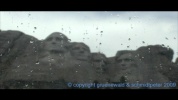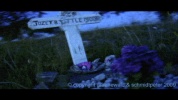Concept
Mt. Rushmore is one of the most visited tourist attractions in America and one of the best-known symbols of the United States. Wounded Knee is the location of the last massacre of Native Americans and the symbol for the persecution and expulsion of the continent’s native peoples. As confirmed by the Supreme Court in 1980, the Black Hills, where the president’s busts were carved into granite walls, rightfully belong to the tribe whose ancestors were slaughtered at Wounded Knee.
The documentary shows for the first time how those two contrasting places are connected in the past and the present. A montage of interviews and images upends our understanding of both iconic places and, thereby, also undermines the conventional wisdom about the United States as a developed nation governed under the rule of law.
The film thrives on the contrast of nature and society between the two locations. The landscape around Wounded Knee is a mythical desert-like space of endless grass-covered mounds. It is quiet and empty. Mt Rushmore is located in the nearby Black Hills, which is a low mountain range with bizarre granite rock formations. The monuments and the nature parks attract millions of visitors each year and the area features the typical commercial infrastructure of mass tourism.
Wounded Knee consistently ranks as one of the poorest communities in the United States with an annual per capita income around $ 5000 and a life expectancy slightly under 50 years, below that of Ruanda or Somalia. Unemployment and Alcoholism rates are around 90%. In contrast, the area around Mt Rushmore is the wealthiest in the region thanks to the tourist industry and the gold that has been mined in the Black Hills for over 100 years.
Those two worlds collide in over 60 interviews of stakeholders from both places. From the perspective of the Native Americans, the wounds of the past determine their lives today. On the other hand, most white Americans ignore, deny, and repress past and present injustice. The film takes a surprising turn as it reveals that the Superintendent of Mt Rushmore is a member of the tribe that was and continues to be victimized, and when, finally, some white visitors appear at the mass grave at Wounded Knee …
At the same time, the film emphasizes the visual and acoustic experience of both places. The thematic disparity is reflected in the contrasting atmosphere of the images and soundscapes for both places. The impact of the visuals is amplified through an original soundtrack by the digital sound artist Stephan Mathieu.
Format: DV, 16:9
Duration: 90 min. / 55 min.
|
 |

